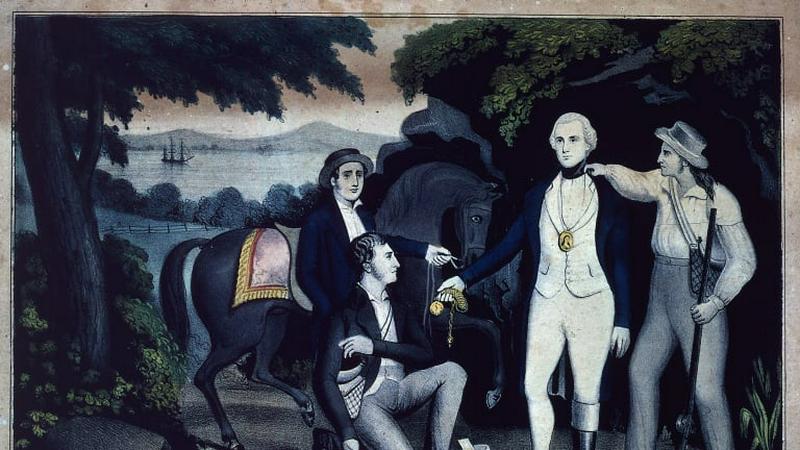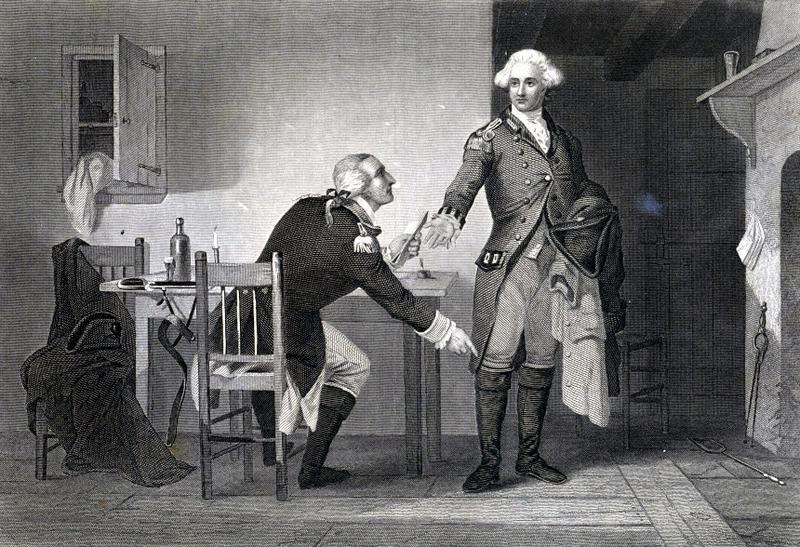The Culper Ring: George Washington's Real Secret Spy Organization
By | March 2, 2021
The British take New York
George Washington may be one of the Founding Fathers of America, but he's also the first member of the U.S. government to take America into the spy game. In 1778, New York City was under siege by the British military. The Redcoats had essentially set up shop in the area and were using it as their own personal base of operations. To get to the bottom of England's plans Washington created a group of spies to infiltrate the city and feed him information. Their name: The Culper Ring.
Through the Culper Ring, Washington and his men were able to shut down a series of British plans that would have cut the Continental Army off at the knees. Most importantly, the group discovered a spy in their own midst: none other than Benedict Arnold. The spy ring was kept a secret until the 1930s. These men and women put their lives in danger to keep the colonies safe and no one was the wiser.d

When the British occupied New York City on August 22, 1776, they filled the area with at least 32,000 soldiers, pushing out Colonists and giving chase to Washington and his men through New Jersey. Washington and his men finally escaped across the Delaware and into Pennsylvania by December. Everyone thought the Revolution was done. Thomas Paine called it "the times that try men's souls."
Washington and the Colonial Army had no plans to stop their fight, but with General Howe kicking his feet up in New York there was no way to know what the British were going to do. Washington, a man of action, asked for volunteers to go behind enemy lines and had a list of men ready to rock. He selected Captain Nathan Hale to slip into New York City under a false name, but Hale was pretty much immediately caught. Washington rethought his methods and decided that civilians would make better spies, although as the war churned on he took on anyone who wanted to be of service.
The Culper Ring

Lieutenant Caleb Brewster volunteered his services in August 1778. Washington was unsure about another military man getting caught, but Brewster offered up information about British warships and Washington was impressed. Washington put Robert Townsend together with Captain Benjamin Tallmadge and they started bringing in members to their ring. Tallmadge got his friend Abraham Woodhull out of prison to help work intelligence with the group, but he was one of the few guys who worked with the group on a consistent basis.
Tallmadge opted to work with agents on the basis of a long term solo mission. Agents were embedded in New York, New Jersey, and Connecticut for brief periods of time. Usually, agents were sent to areas where they had family so they had legitimate reasons to be in the area. They would stick around for a couple of weeks, make their way beyond British checkpoints and report back to Tallmadge. In some cases, couriers were tasked with dropping off messages at a series of coves around Seatauket.
After picking up the messages, Caleb Brewster would deliver them across Long Island Sound on a whaleboat to Tallmadge in Connecticut. From there, the messages would be brought to Washington. All of those steps to get messages to Washington took way too long for the General so he insisted on using overnight express riders to get notes to him with expediency. Reports were written under the names Samuel Culper, Jr. and Samuel Culper, Sr., with Townsend writing as the former and Woodhull as the latter.
Codes and keys

Every spy ring needs their secret codes and the Culper Ring was no different. Anna Smith Strong, a woman in Setauket, New York, wanted to get back at the British military for imprisoning her husband, so she helped out whenever she could. She used various pieces of laundry on her clothesline as a way to let Woodhull know where Brewster was waiting for a meeting. A black petticoat meant that Brewster was in town, and depending on the number of handkerchiefs hanging on the line Woodhull would know in which of the six locations they would be meeting. It's possible that this particular story is apocryphal, but it's pretty cool either way, and would have been a really badass way to communicate.
All of the agents involved in the Culper Ring received codenames. Washington was Agent 711, while Tallmadge created a book of three digit codes that could be deciphered into a variety of words. It's believed that the group had 763 different coded words with 701 meaning "woman," and 223 meaning "gold."
Bringing down the British

Washington was never happy with the amount of information that the Culper Ring brought to him, but that's a general for you. He put the group under constant pressure to bring in new intelligence but even though he was breathing down their neck they managed to crack some serious news about the British military. From 1778 to 1783, the group kept tabs on the British military's movements and plans in the New York area, but it was the information gathered on their plan to attack the French army in Rhode Island that likely saved the war effort.
Around 1779, the British military planned to absolutely wreck the Colonial Army through economic means. First, they wanted to create large amounts of counterfeit currency printed on the paper used for Continental dollars, but with information from the Culper Ring, the Continental Congress took the bills out of circulation. They then attempted to attack the French military when they pulled into Rhode Island. Once again, the Culper Ring put the kibosh on this plan and kept the Franco-American alliance alive.
It's believed that the Culper Ring also played a role in the capture of Benedict Arnold after he agreed to surrender West Point to the British for £20,000.
The Culper Ring saved Washington's life

The Colonial Army may have been lacking numbers but the one thing they had on the British was their underground intelligence. The Culper Ring weren't the only spies working during the war, they were just the only consolidated group. There were dozens of lone wolf spies embedded throughout the colony feeding information back to the military. If the British military caught one spy they still had an entire nest of revolutionaries to deal with.
Hercules Mulligan was working as a spy for the Colonial Army a few years before the Ring got its start. He owned a popular tailoring shop in New York City which meant that anyone who was anyone passed through his doors. He kept his ears open while he worked and passed that information along to connections in the Colonial Army. Mulligan's most important discovery was that the British were planning to take General Washington out as he rode to meet General Rochambeau on March 5, 1781. Mulligan gave the information to Robert Townsend who then passed the intelligence to the Ring who told Washington about the plot. He took a different route and lived to fight another day.
When the war came to an end in 1783, The Culper Ring was, for all intents and purposes, no longer operational. Outside of the people involved no one knew about it until Long Island historian Morton Pennypacker matched the handwriting of the "Culper, Jr." letters to the handwriting of Robert Townsend. The discovery of the long defunct Culper Ring was announced at a meeting of the New York State Historical Society on September 27, 1930.

